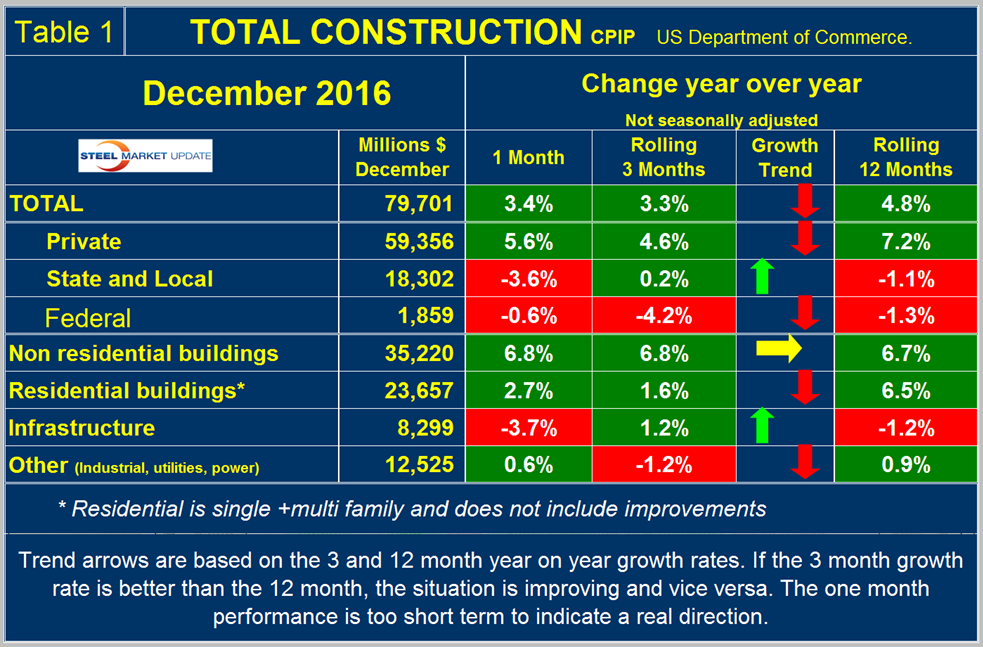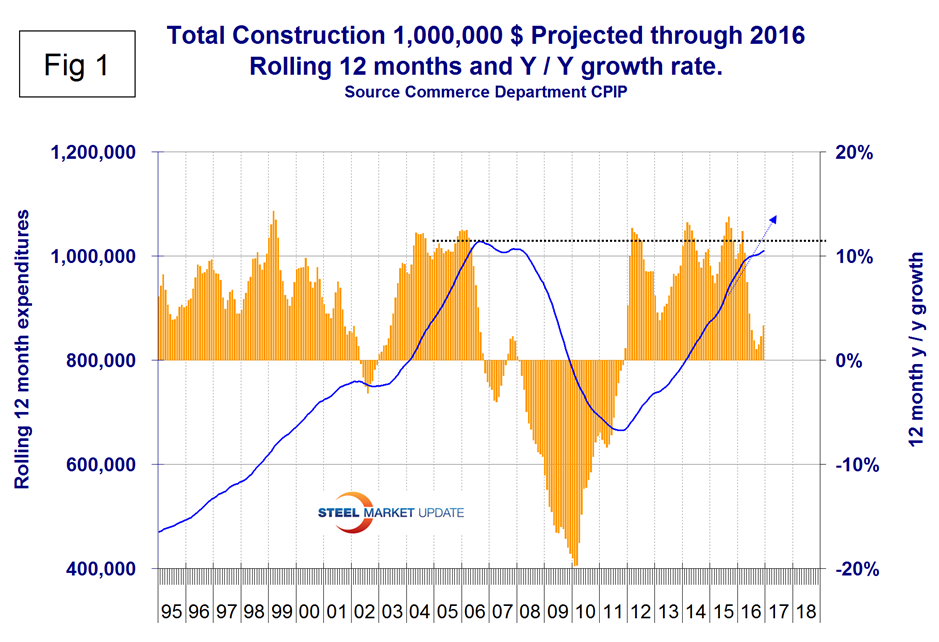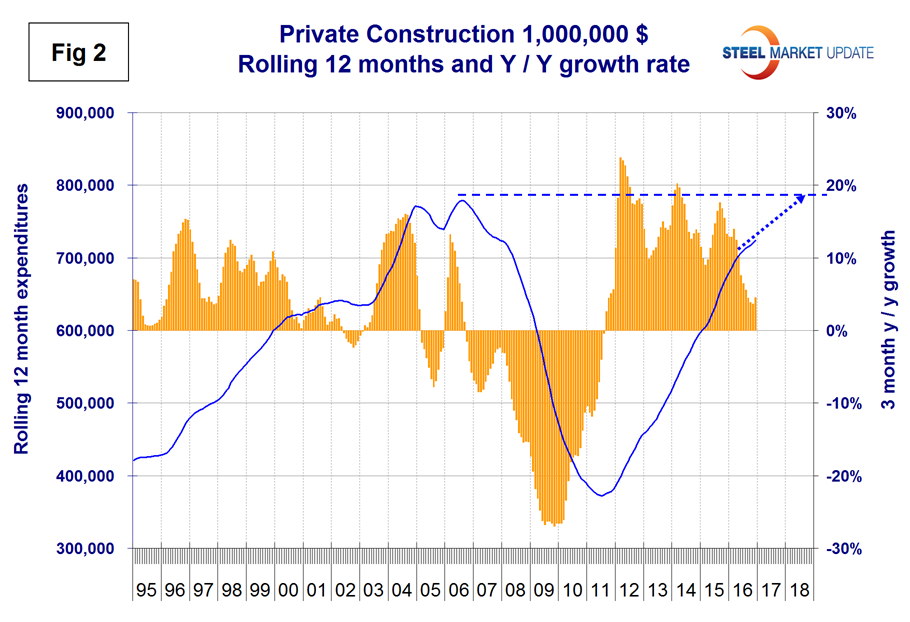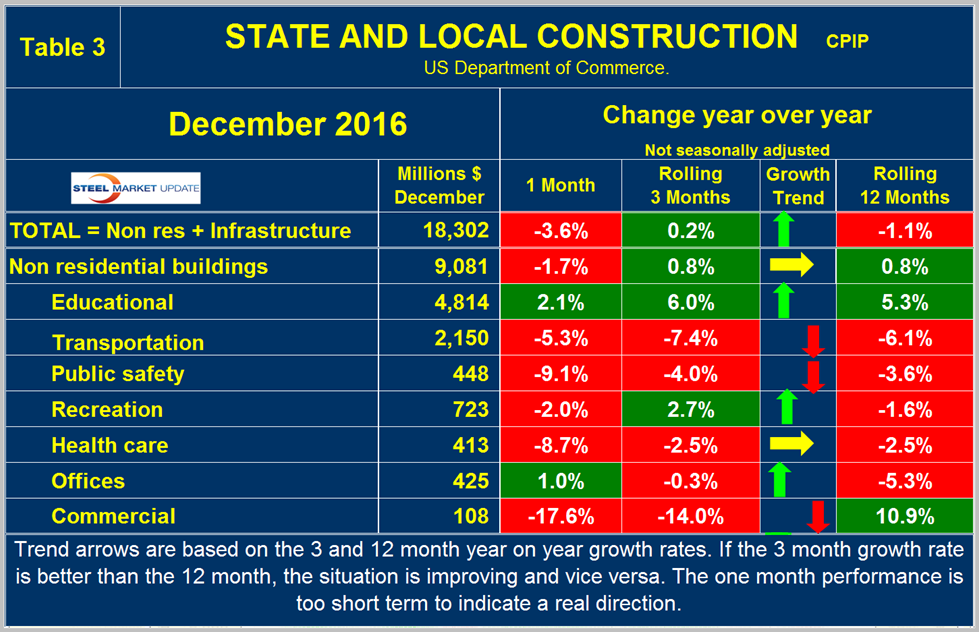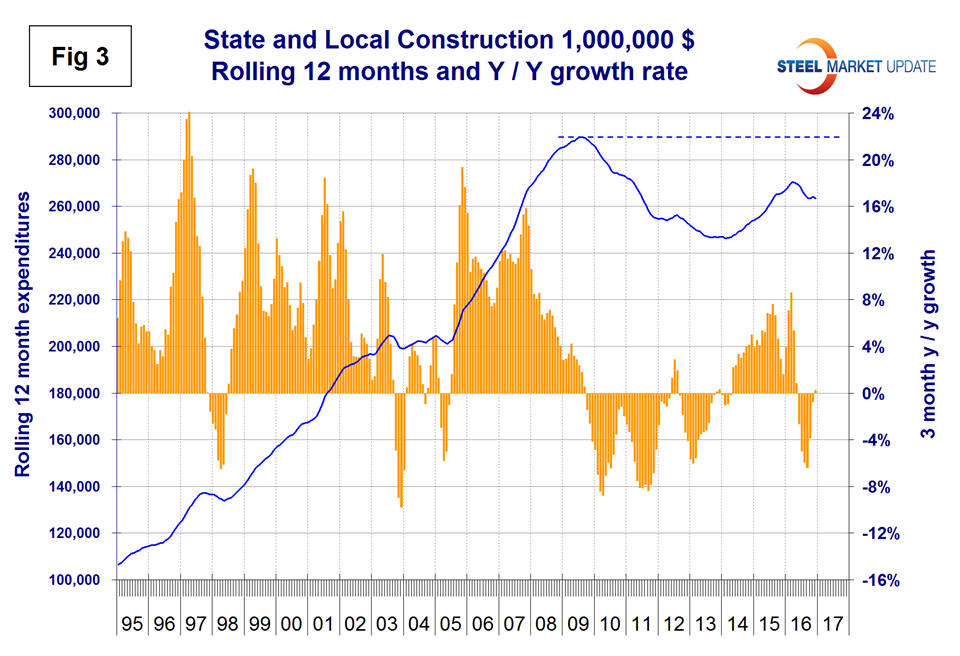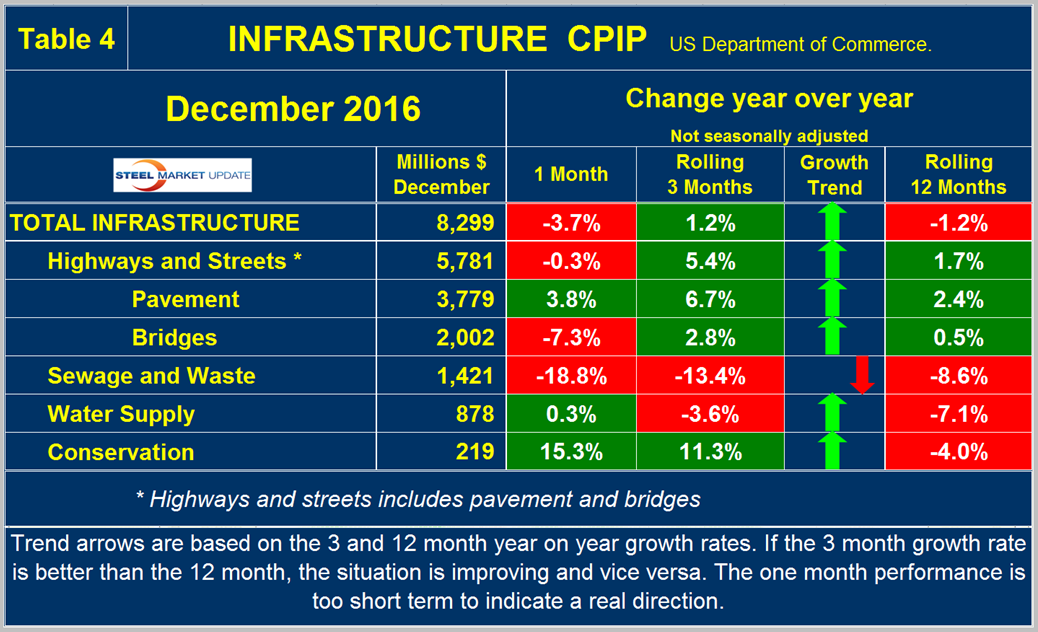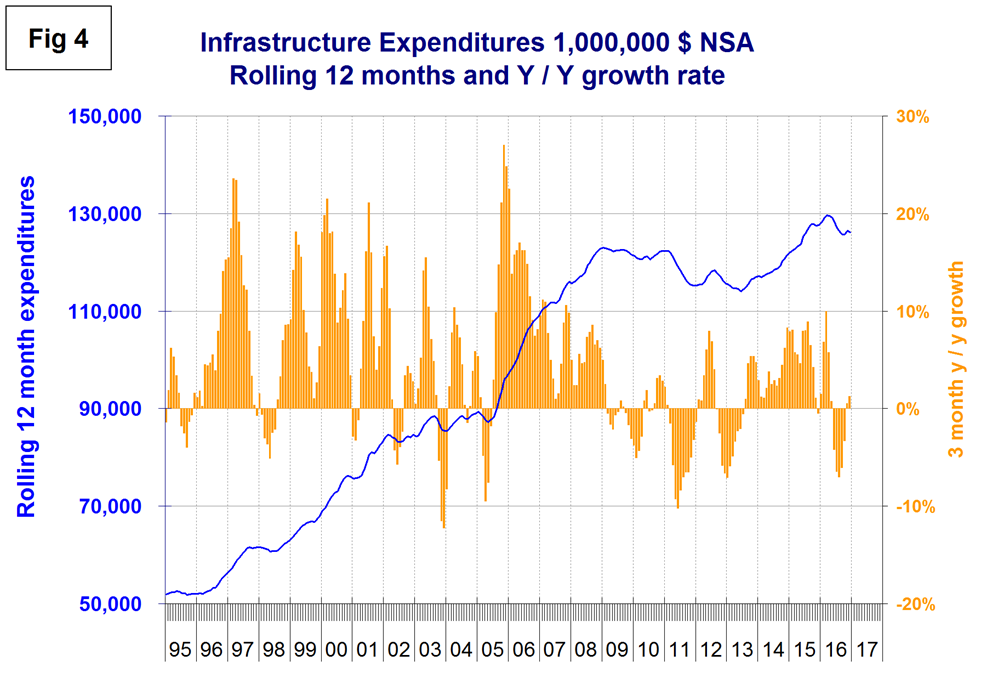Steel Markets

Construction Expenditures through December 2016
Written by Peter Wright
February 3, 2017
December data for Construction Put in Place (CPIP) was released by the Department of Commerce on Wednesday February 1st 2017. We reported last month that $305 billion infrastructure to the bill that Congress passed in December 2015 might be beginning to kick in and this perception was strengthened in the December data.
![]() At SMU we analyze the CPIP data with the intent of providing a clear description of activity that we believe accounts for over 30 percent of total steel consumption. Please see the end of this report for more detail on how we perform this analysis and structure of the data but in particular note that we are presenting NONE seasonally adjusted numbers. Much of what you will see in the press may differ from our presentation because others are basing their comments on adjusted values. Our rational is that construction is highly seasonal and our businesses function in a seasonal world. Also we don’t understand how the adjustments are made neither do we trust them.
At SMU we analyze the CPIP data with the intent of providing a clear description of activity that we believe accounts for over 30 percent of total steel consumption. Please see the end of this report for more detail on how we perform this analysis and structure of the data but in particular note that we are presenting NONE seasonally adjusted numbers. Much of what you will see in the press may differ from our presentation because others are basing their comments on adjusted values. Our rational is that construction is highly seasonal and our businesses function in a seasonal world. Also we don’t understand how the adjustments are made neither do we trust them.
Total Construction
Total construction grew by 3.3 percent in three months through December year over year. This followed a 2.3 percent improvement in November. On a rolling 12 months basis construction expanded y/y by 4.8 percent in December which was the 57th consecutive month of positive growth. All growth measures included below are on a 3MMA basis year over year which is our way of eliminating seasonality. On a three month basis growth slowed to 1.0 percent y/y in September but improved each month of the fourth quarter.
December total construction expenditures were $79.7 billion which breaks down to $59.4 B of private work, $18.3 B of state and locally (S&L) funded work and $1.9 B of federally funded (Table 1).
The red and green arrows in all four tables in this report show momentum. The fact that December’s growth of 3.3 percent on a 3MMA basis was lower than the 4.8 percent growth on a rolling 12 months basis means that the growth rate still has negative momentum. In our spring construction updates we expressed the opinion that total construction would reach the pre-recession level by the end of this year. This projection is no longer true but could happen by the middle of 2017 as shown by the blue line in Figure 1.
We consider four sectors within total construction. These are non-residential, residential, infrastructure and other. The latter is a catch all and includes industrial, utilities and power. Of these, infrastructure had positive momentum, non-residential buildings were flat, residential buildings and other had negative momentum in December. The growth rate of total construction is shown by the brown bars in Figure 1. The pre-recession peak of total construction on a rolling 12 month basis was $1.028 trillion in 12 months through August 2006. The low point was $665.1 B in 12 months through December 2011. The 12 month total through the latest data of December 2016 was $1.010 trillion. August through December on a rolling 12 month basis were the first months to exceed the $ trillion level since May 2008.
Private Construction
Table 2 shows the breakdown of private expenditures into residential and non-residential and subsectors of both.
The growth rate of private construction was 4.6 percent in the three months through December with a slowing trend as shown by the brown bars in Figure 2.
The blue lines in all four graphs in this report are 12 month totals which smooths out seasonal variation. Excluding property improvements our report shows that single family residential contracted by 0.3 percent and multi-family residential still has a healthy 10.1 percent growth rate. The growth rates of both single family and multi-family construction expenditures reported here are different from the growth of starts reported by the Census Bureau. (In the starts data the whole project is entered to the data base when ground is broken). Single family starts grew at 10.0 percent in 3 months through December and multi-family starts grew by 16.0 percent. It remains to be seen whether the difference between ongoing expenditure growth and the growth in starts portends a future surge in single family. Within private non-residential, momentum improved in December compared to our last update when all sectors except commercial, offices and educational had negative momentum. In December only four sectors had negative momentum, these were manufacturing, lodging, recreational and religious. The fourth quarter Federal Reserve Senior Loan Officer Survey indicated that there is currently a net increase in demand for construction and land development loans but that terms are tightening. The Fed survey reviews changes in the terms of, and demand for, bank loans to businesses on a quarterly basis based on the responses from 73 domestic banks and 24 U.S. branches and agencies of foreign banks.
State and Local Construction
S&L work grew by 0.2 percent in the rolling three months through December y/y with positive momentum (Table 3).
This was the first month of positive growth after six consecutive month of contraction. Figure 3 shows year over year growth as the brown bars and the rolling 12 month total of expenditures as the blue line.
Educational buildings are by far the largest sub sector of S&L non-residential at $4.8 billion. In December on a 3MMA basis y/y educational had a positive growth of 6.0 percent with positive momentum. Recreational also had positive growth in December as all other sectors contracted. Comparing Figures 2 and 3 it can be seen that S&L construction did not have as severe a decline as private work during the recession and that private work bounced back faster. Private expenditures still could exceed the pre-recession high in 2018 but the downturn in S&L means that a full recovery will probably not be achieved this decade.
Drilling down into the private and S&L sectors as presented in Tables 2 and 3 shows which project types should be targeted for steel sales and which should be avoided. There are also regional differences to be considered for which data is not available from the Commerce Department.
Infrastructure
Expenditures contracted for five straight months through October before returning to positive growth in November and December when growth was positive 0.5 percent and 1.2 percent respectively. Prior to June there was a string of 34 out of 35 months with positive growth. Highway and streets including pavement and bridges returned to positive growth of 4.4 percent in three months through November and 5.4 percent through December after five straight months of contraction. These account for about 2/3 of total infrastructure expenditures. All infrastructure segments except sewage and waste and water supply had positive growth in three months through December y/y which was a startling turnaround from our October report. Highway pavement is the main subcomponent of highways and streets and had a 6.7 percent positive growth in three months through December. Bridge work had negative growth of 4.9 percent in October but rebounded to positive 2.7 percent in November and 2.8 percent in December (Table 4).
Infrastructure expenditures were slow to respond to the recession due to the magnitude of many of these projects. Growth stopped in 2009 and 2010 but it wasn’t until 2011 that an actual contraction occurred. Infrastructure expenditures have exceeded the pre-recession high every month since May 2015 but until November were clearly in a downturn (Figure 4).
It looks as though the passage in December 2015 of the congressional bill for $305 billion to fund roads, bridges, and rail lines may finally have begun to kick in, delayed by the long planning and permitting processes for such projects. The five-year infrastructure bill is the longest reauthorization of federal transportation programs that Congress has approved in more than a decade, ending an era of stopgap bills and half-measures that left the Highway Trust Fund nearly broke and frustrated local governments and business groups.
Total Building Construction including Residential
Figure 5 compares YTD expenditures for building construction for 2015 and 2016.
Single family residential is dominant and in the 12 months of 2016 totaled $243 billion, up from $233 billion in 2015. Manufacturing, transportation and public safety contracted in 2016 y/y, all other sectors expanded led by lodging (hotels and motels) which was up by 26.4 percent, offices up by 25.7 percent and multi-family residential buildings up 15.4 percent.
Explanation: Each month the Commerce Department issues its construction put in place (CPIP) data, usually on the first working day covering activity two months earlier. Construction put in place is based on spending work as it occurs, estimated for a given month from a sample of projects. In effect the value of a project is spread out from the project’s start to its completion. This is different from the starts data published by the Census Bureau for residential construction, by Dodge Data & Analytics and Reed Construction for non-residential and Industrial Information Resources for industrial construction. In the case of starts data the whole project is entered to the data base when ground is broken. The result is that the starts data can be very spiky which is not the case with CPIP.
The official CPIP press release gives no appreciation of trends on a historical basis and merely compares the current month with the previous one on a seasonally adjusted basis. The data is provided as both seasonally adjusted and non-adjusted. The detail is hidden in the published tables which we at SMU track and dissect to provide a long term perspective. Our intent is to provide a rout map for those subscribers who are dependent on this industry to “Follow the money.” This is a very broad and complex subject therefore to make this monthly write up more comprehensible we are keeping the information format as consistent as possible. In our opinion the absolute value of the dollar expenditures presented are of little interest. What we are after is the magnitude of growth or contraction of the various sectors. In the SMU analysis we consider only the non-seasonally adjusted data. We eliminate seasonal effects by comparing rolling three month expenditures year over year. CPIP data also includes the category of residential improvements which we have removed from our analysis in the rational that such expenditures are minor consumers of steel.
In the four tables included in this analysis we present the non-seasonally adjusted expenditures for the most recent data release. Growth rates presented are all year over year and are the rate for the single months result, the rolling 3 months and the rolling 12 months. We ignore the single month year/year result in our write ups because these numbers are preliminary and can contain too much noise. The arrows indicate momentum. If the rolling 3 month growth rate is stronger than the rolling 12 months we define this as positive momentum and vice versa. In the text, when we refer to growth rate we are describing the rolling 3 months year over year rate. In Figures 1 through 4, the blue lines represent the rolling 12 month expenditures and the brown bars represent the rolling 3 month year over year growth rates.

Peter Wright
Read more from Peter WrightLatest in Steel Markets
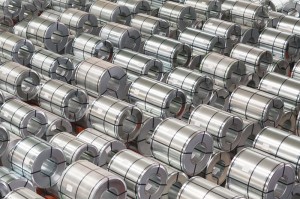
Hot-rolled sources say demand continues to dwindle, prices feel arbitrary
Genuine demand, they stated, will return when the market feels stable again.

FabArc Steel Supply completes projects in Mississippi, Georgia
FabArc Steel Supply announced this week the completion of two large-scale projects in Georgia and Mississippi.
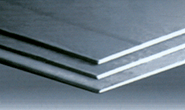
Thin demand keeps plate prices hovering at lowest levels since February
Participants in the domestic plate market say spot prices appear to have hit the floor, and they continue to linger there. They say demand for steel remains thin, with plate products no exception.

Worldsteel: Global steel demand flat, but modest rebound forecast for 2026
The World Steel Association (worldsteel) Short Range Outlook for global steel demand predicts that 2025’s steel demand will clock in at the same level as in 2024. In its October report, the Brussels-based association stated that this year’s steel demand will reach ~1,750 million metric tons (mt). The organization forecasts a 1.3% demand rebound in 2026, pushing […]

CRU: China’s indirect steel exports find new destination markets
The boom in China’s direct steel exports has not stopped this year, even with a rise in protectionist measures globally. The increase is driven by...

